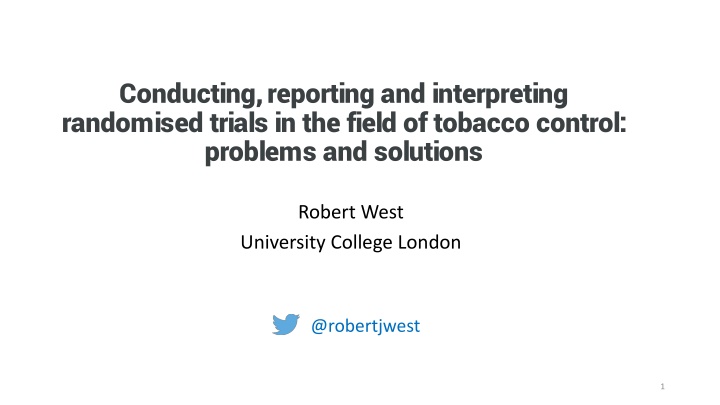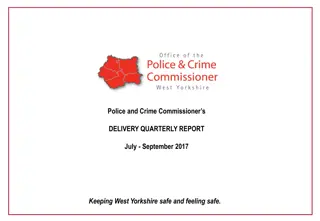
Challenges and Solutions in Tobacco Control Randomised Trials
Explore the complexities of conducting randomised trials in tobacco control, including issues with generalisation, causality, data analysis, and reporting. Learn about the features of an RCT and understand what RCTs are ideal for and what they are not suited for. Dive into the nuances of external validity and the various factors influencing the outcomes of such trials.
Download Presentation

Please find below an Image/Link to download the presentation.
The content on the website is provided AS IS for your information and personal use only. It may not be sold, licensed, or shared on other websites without obtaining consent from the author. If you encounter any issues during the download, it is possible that the publisher has removed the file from their server.
You are allowed to download the files provided on this website for personal or commercial use, subject to the condition that they are used lawfully. All files are the property of their respective owners.
The content on the website is provided AS IS for your information and personal use only. It may not be sold, licensed, or shared on other websites without obtaining consent from the author.
E N D
Presentation Transcript
Conducting, reporting and interpreting randomised trials in the field of tobacco control: problems and solutions Robert West University College London @robertjwest 1
Statement of potential competing interests I have previously undertaken research and consultancy for companies that develop and manufacture smoking cessation medicines (Pfizer, GSK, J&J) I am leading, unpaid, on development of the online Paper Authoring Tool mentioned in the presentation which has received funding from The Society for the Study of Addiction, Cancer Research UK, The Wellcome Trust, and Northwell Health My personal values prioritise maximising people s wellbeing and improving the objectivity and efficiency of public health and behavioural science 2
Overview RCTs: What are they good for ...? Issues with Generalising from RCTs (External validity) Inferring causality from RCTs (Internal validity) Analysing data from RCTs Reporting RCTs Solutions 3
Features of an RCT Participants: e.g. cigarette smokers willing to use cessation treatment Setting(s): e.g. family practices in the US Intervention(s): e.g. offer of free disposable e-cigarette for 12 weeks Control(s) e.g. offer of choice of licensed nicotine replacement therapy Exposure e.g. at least one day of use Outcome(s) e.g. complete tobacco abstinence for at least 6m 4
What are RCTs good for? Answering simplecomparative questions (Is A better than B?) in a relevant context When it is feasible to deliver interventions with sufficient fidelity recruit a relevant sample of sufficient size maintain the purity of the interventions being compared achieve sufficient follow-up achieve accurate measurement of relevant outcomes 5
What are RCTs not not good for? Everything else 6
Issues with external validity Interventions complexity source purity fidelity adherence Study sample volunteers retention Context demand characteristics historical context current context Outcome inclusiveness relevance measurement 7
Issues with internal validity Interventions randomisation failure differential purity differential uptake differential fidelity differential adherence Study sample blinding differential attrition Context external influences Outcome multiple outcomes measurement bias 8
Issues with analysis Specification of outcome variables Choice of outcomes variable(s) Choice of comparative statistic Choice of statistical approach 9
Issues with reporting Incomplete information Variably expressed Hard to find Incorrectly interpreted Selectively included or highlighted findings 10
Solutions Research question framework RCT appropriateness checklist (RCT-AC) RCT issue-mitigation checklist (RCT-IMC) Paper Authoring Tool (PAT) Triangulation 11
A well formed research question S I E O P E C What is the effect of [Intervention(s)] versus Comparator(s)] among [Population] in [Setting(s)] on [Outcome(s)] with [Exposure] 12
RCT Appropriateness Checklist Is it valuable to answer a simple comparative question? Is it feasible to set up a relevant context? Is it feasible to: deliver intervention(s) and comparator(s) with appropriate fidelity? recruit a relevant sample? recruit a sample of sufficient size? maintain the purity of the interventions being compared? achieve sufficient and balanced follow-up? measure all relevant outcomes? to achieve accurate measurement in intervention and comparator groups? 13
RCT Issue-Mitigation Checklist What steps have you taken to: pre-register a full protocol and analyses plan minimise randomisation failure? assess and adjust for randomisation failure? maximise and assess setting relevance? maximise and assess study sample representativeness? ensure and assess blindness of participants, researchers, statisticians minimise and assess contamination ensure and assess intervention and comparator fidelity ensure and assess intervention and comparator uptake and adherence minimise and assess attrition and reasons for it fully pre-specify all important outcomes and differentiate primary and secondary maximise measurement accuracy and minimise bias undertake sensitivity analyses under widely varying missing value assumptions 14
paperauthoringtool.com A free online tool for writing up RCTs and Pilot RCTs Can be used to develop protocols Can be used for study components (e.g. measures, interventions) Promotes best practice in writing research reports (e.g. CONSORT, TIDIER) Ensures that all the required information is included from the very first draft Supports collaborative working Minimises the need for multiple revisions and corrections Uses ontologies and programming to provide intelligent prompts Creates a draft paper in Word and a machine readable JSON file
Triangulation RCTs Individual-level comparative studies Population level comparative studies 16
Conclusions RCTs can be powerful research tools but have limited applicability When planning and evaluating RCTs it is important to assess whether this is the appropriate approach When planning RCTs and reporting and interpreting methods and findings it is important to describe all SPICEO information using a detailed framework (e.g. PAT) When planning RCTs and reporting and interpreting findings it is important to describe and evaluate all steps taken to maximise internal and external validity Where there is reasonable and significant doubt about the internal or external validity of RCT findings it is important to use other designs to triangulate on key conclusions When evaluating RCTs and other research designs it is important to accept that all studies have limitations and conclusions should be expressed in a way that reflects these BUT not selectively dismissing results that conflict with pre-conceived ideas 17






















